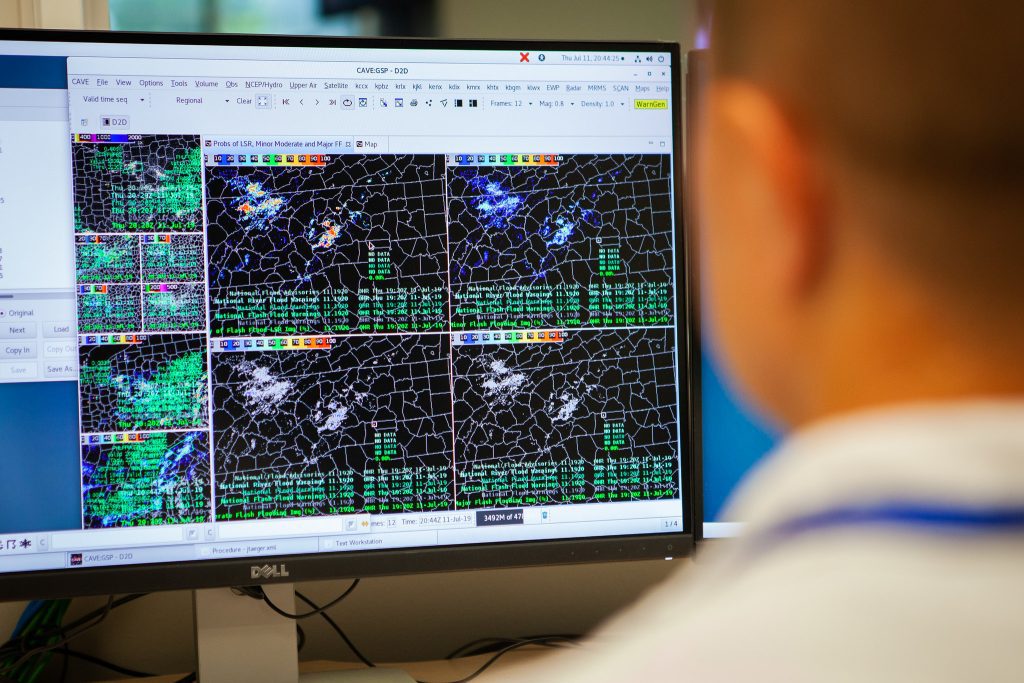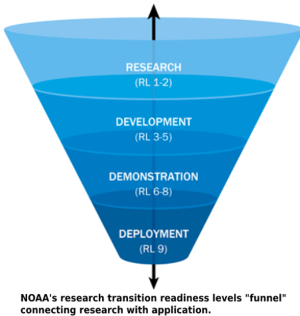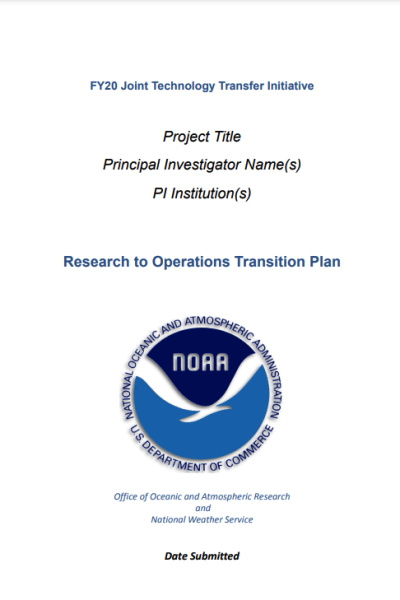NOAA’s Policy on Research Transitions (Administrative Order 216-105B) guides WPO’s research transition initiatives. This policy implements Transition Plans for all R&D projects intended to transition to a further application and Readiness Levels (RLs) to track the progress of R&D projects.

WPO Prioritizes Research Transitions
We fund research that will ultimately benefit society through improved forecasting.
Societal Applications for Funded Research
Research Transitions to Operations
The Weather Program Office’s mission is to develop and transition weather research to societal applications. In alignment with the Weather Research and Forecasting Innovation Act of 2017, WPO aims to support research and development (R&D) projects that lead to improved understanding of tropical cyclones, severe storms, extreme precipitation, air pollution, and social science, and an integration of weather, water, and climate forecasting and hazard communication.
Successful transition of research to operations (R2O), commercialization and public release (R2C), application (R2A), or any other specialized use (R2X) requires strong and consistent coordination within NOAA and across line offices and fields within the weather enterprise, beginning at the start of transitionable R&D projects.
As a result, WPO prioritizes R2X capability in its funding opportunities and project management strategies for all of its programs. WPO’s transition management is coordinated closely with the OAR Office of Research Transitions and Applications (ORTA), NOAA Testbeds and Proving Grounds Coordination Committee (TBPGCC), and NWS Office of Science and Technology Integration (OSTI), and other related organizations. These groups provide additional resources for transition planning.
Current Focus Areas
Research Transition Support
Data and Research Support
Portfolio Analysis and Evaluation
Identifying & Funding Research Transitions with
NOAA Readiness Levels

Collaborative Funding Opportunities, particularly the annual Notice of Funding Opportunity (NOFO), are the primary mechanism for supporting transitionable R&D projects. WPO continually engages its partners, especially in OAR, NWS, and academia, to better inform research priorities. Input from operational centers and external partners allows WPO to regularly identify and assess current science gaps and develop funding priorities to address them.
Readiness Levels (RLs) are how NOAA tracks the progression of transitionable R&D projects along a spectrum of Basic Research (RL1) through operational transition (RL9). NOAA uses RLs to characterize the status of R&D relative to its readiness to be used operationally or in other societal applications. Projects reaching RL4 (successful testing in experimental environment) or beyond are required to complete a transition plan.
Readiness Level 1: Basic Research
RL 1: Basic research, experimental or theoretical work undertaken primarily to acquire new knowledge of the underlying foundations of phenomena and observable facts, without any particular application or use in view. Basic research can be oriented or directed towards some broad fields of general interest, with the explicit goal of a range of future applications (OECD, 2015).
Readiness Level 2: Applied Research
RL 2: Applied research, original investigation undertaken in order to acquire new knowledge. It is, however, directed primarily towards a specific, practical aim or objective. Applied research is undertaken either to determine possible uses for the findings of basic research, or to determine new methods or ways of achieving specific and predetermined objectives (OECD, 2015).
Readiness Level 3: Proof of Concept
RL 3: Proof-of-concept for system, process, product, service, or tool; this can be considered an early phase of experimental development; feasibility studies may be included.
Readiness Level 4: Successful Evaluation
RL 4: Successful evaluation of system, subsystem, process, product, service, or tool in a laboratory or other experimental environment; this can be considered an intermediate phase of development.
Readiness Level 5: Successful Evaluation II
RL 5: Successful evaluation of system, subsystem process, product, service, or tool in relevant environment through testing and prototyping; this can be considered the final stage of development before demonstration begins.
Readiness Level 6: Demonstration of Prototype
RL 6: Demonstration of a prototype system, subsystem, process, product, service, or tool in relevant or test environment (potential demonstrated).
Readiness Level 7: Prototype Functionality
RL 7: Prototype system, process, product, service or tool demonstrated in an operational or other relevant environment (functionality demonstrated in near-real world environment; subsystem components fully integrated into system).
Readiness Level 8: Finalization
RL 8: Finalized system, process, product, service or tool tested, and shown to operate or function as expected within the user’s environment; user training and documentation completed; operator or user approval given.
Readiness Level 9: Deployment
RL 9: System, process, product, service or tool deployed and used routinely.
Writing a Transition Plan
Roles and Responsibilities
An R&D project funded through a WPO program will have one or more Point of Contact (POC) at the organization proposed to receive the transition. For example, for projects intending to transition output to the National Weather Service (NWS), the receiving office will most often be from an NCEP operational center or Headquarters office. Principal Investigators (PIs) of WPO projects are responsible for coordinating the development of a Transition Plan with their POC. The PI will provide information about the project and its milestones and ultimate goals. The POC is expected to provide input about the technical and financial requirements and limitations for completing the proposed transition.
Review & Approval
NOAA transition plans must ultimately be signed by the Assistant Administrator (AA) and Line Office Transition Manager (LOTM) of the affected Line Offices. WPO manages a process to ensure that draft plans submitted by the PI and POC are sufficiently reviewed and vetted by technical experts prior to LOTM and AA review. At any point in the approval process, the PI and POC may be asked to provide edits or responses to specific concerns.
Reviewers may include:
- WPO Program Management
- Receiving Office Director or designee
- NOAA research laboratory (for projects involving a substantial investment by a NOAA Lab)
- WPO Director
- Relevant NWS Service Delivery Portfolios (for proposed transitions to NWS operations, as coordinated by NWS Office of Science and Technology Integration)
The PI is responsible for submitting an unsigned draft transition plan to their funding program within (at most) six months from the project start date. WPO will then coordinate the review process and collection of signatures. A completed transition plan will include signatures from:
- Project POC
- Director of proposed receiving office
- WPO Director
- LOTM of affected line offices
- AA of affected line offices
Additional Resources
For general resources on transition planning in NOAA, visit The Office of Research, Transition & Application.
For additional information on transition plans, visit the NOAA Research Council website on the Policy on Research and Development Transitions.
NOAA Research Council has also made available several example transition plans.
For more information on transition plans for the Weather Program Office, please contact laura.dehaan@noaa.gov or valbona.kunkel@noaa.gov.
